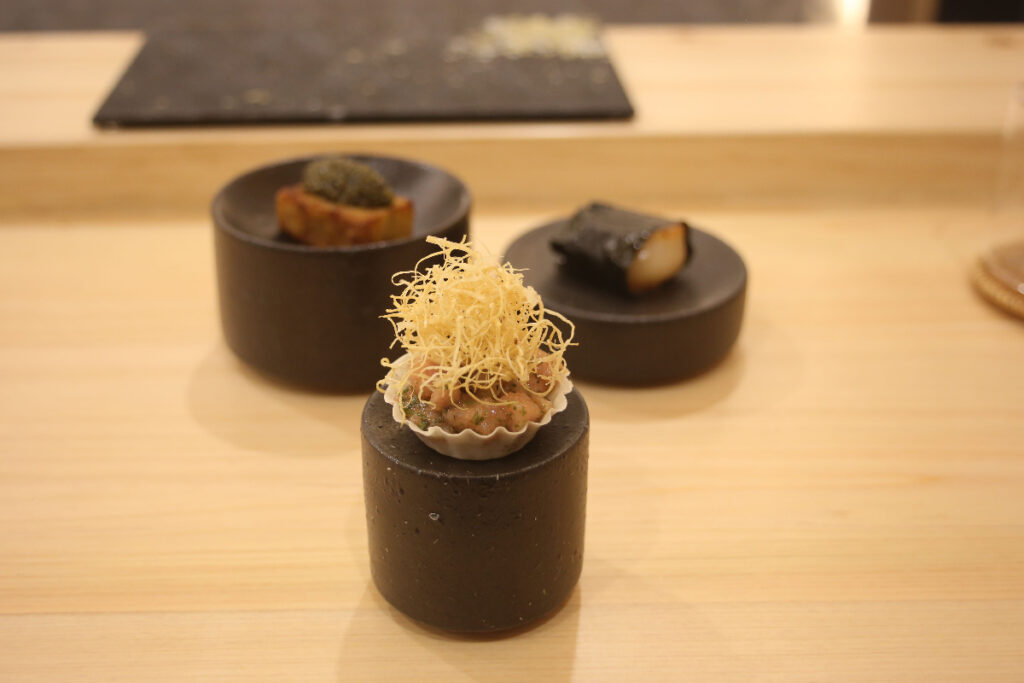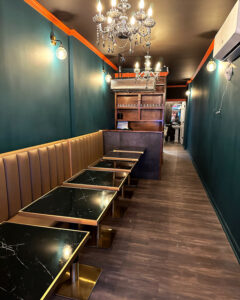In Japan, “kaiseki” refers to a traditional multi-course meal, built around the finest seasonal ingredients. Many restaurants use this terminology in New York, but very few true kaiseki masters actually exist outside of Japan. For Tsubame, Chef-Owner Jay Zheng has created a kaiseki-inspired omakase experience to honor the rich traditions, but not to claim them as his own.
Sign up now to get our Daily Breaking News Alerts
In classic kaiseki style, the menu is a series of colorful assemblages made with the finest seasonal ingredients and fish, mainly sourced from Japan. His finished dishes reference Japanese classics, but also touch broadly on his own roots and influences. Chef Zheng adds some Western ingredients like caviar and truffles to the mix.
Born in rural China with frequent visits to Japan as a young man where he gained expansive Japanese cultural knowledge, the family then migrated to the Midwest, where he grew up working in his family’s restaurants. Educated as an engineer, he tried the business world after college, but hospitality quickly drew him back. Stints at the Peninsula Hotel in Chicago hooked him on fine dining.
Chef Zheng opened his first Japanese fusion restaurant in Indiana in 2012. Hoping for a more appreciative audience for real Japanese flavors he moved to New York in 2016 and opened Gaijin, an upscale sushi restaurant in Astoria, Queens. After the pandemic, he relaunched it as Kōyō, where he took over as Executive Chef and served his first kaiseki-inspired tasting menus.
Always having his heart set on opening in Manhattan, he found this location in Tribeca for his latest venture, Tsubame. Named for the barn swallow that nested in his childhood village in spring, the single, minimally decorated room is occupied entirely by the 10-seat chef’s counter. Like many kappo spots in Japan, Tsubame is very serious about the food, but less formal and more interactive, with Chef Zheng doing almost all the prepping and serving himself.
Tsubame offers an eight-course tasting progression, following a standard kaiseki format. Varied culinary techniques and combinations that help bring out the natural flavors of seasonal ingredients.
Sakizuke – the amuse bouche – launches the meal. Chef Zheng’s Shiroebi Uni Shokupan is a big opener, housemade milk bread layered raw baby shrimp from Toyama and vivid uni from Hokkaido, garnished with shiso flowers.
Yakimono, in more traditional fashion, is a grilled fish course. Japanese Amadai (tilefish) is crisped yubiki style with hot oil before it is finished on a binchotan grill, served with house made negi shoyu (green onion and soy sauce) over baby corn. The Mushimono that follows features Dungeness crab, and nagaimo (mountain yam), layered in an egg custard that is finished a slurry of kudzu and shaved black truffles.
Futamono (lidded dish) is A5 Miyazaki Wagyu Shabu Shabu with udon made of pressed sawara (Spanish mackerel), in awase dashi, is a tribute to Chef’s family fish noodle. It is accompanied by a jidori egg in sweet shoyu (soy sauce) for dipping.
The entrée is Gohan, a rice course served in two different sets beginning with a nigiri progression and ending with a small rice bowl. For his nigiri, chef favors a fluffy, lightly seasoned blend of two grains of koshihikari rice, Tsubame will serve seven to eight piece of nigiri for each seating, which may include: ten day aged Shima aji (striped jack); Kinmedai (golden eye snapper) from Chiba; Barracuda from Kamasu; lightly cured Iwashi (sardine); Aji (horse mackerel) from Oita; Toro (tuna) from Spain; and Muki Hotate (scallop) from Miyagi. The proceeding rice bowl is composed of Uni from Hokkaido and Ossetra caviar over koshihikari rice.
The experience concludes with Mizumono, two light seasonal dessert. The first is a light serving of Hojicha Custard topped with bruléed seasonal fruits. As it is customary to end a kaiseki meal with tea, Tsubame serves ceremonial Uji Matcha Green tea from Kyoto with seasonal fruit.
Tsubame offers a growing sake list sourced from World Sake Imports as well as Japanese beers and a tea selection, with a wine program coming soon.
The interior was designed by AESAM based in Hong Kong in a minimalist fashion with blonde wood and a white textured wall that is inset and backlit. The tasting counter is lined with high, black velvet barstools trimmed in gold. At the entrance are handblown white glass birds to evoke the restaurant’s namesake.
Tsubame is located at 11 Park Place, New York, NY 10007 (between Tribeca and City Hall) and is open Tuesday – Saturday: Seatings at 5:30 and 8 pm.





